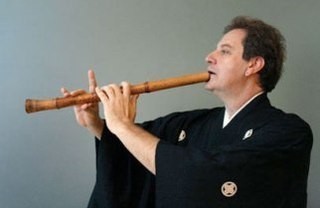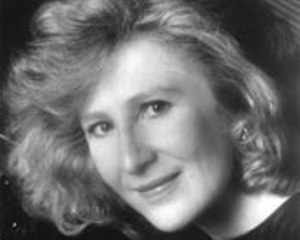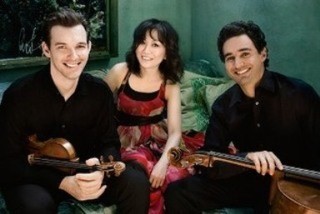|
Back
Rituals and Richness New York
BargeMusic
01/01/2015 -
Here And Now Winter Festival
Rob Davidson: The Art of Agony for solo piano and tape (World Premiere)
Brett Dean: Equality and Prayer for speaking pianist (New York Premiere)
Anne Gosfield: Burn Again with a Low Blue Flame, for cello and electronics (New York Premiere)
Jesse Mills: Painted Shadow (World Premiere)
James Nyoraku Schlefer: ”Brooklyn” Tsuru no Sugomori (World Premiere)
Roger Stubbiefield: Olsltifuo! (after Caprice Viennois for Piano Trio) (World Premiere)
Ljova Zhurbin: (Piece for Fadolin) (World Premiere)
David Schol: Flight Thirteen: Fugue on the Name of Del Tridici (World Premiere)
David Del Tredici: Mandengo
Amy Williams: Falling
Ursula Oppens, Marc Peloquin, Sonya Lifschitz (Pianos), James Schlefer (Shakuhachi), Ljova Zhurbin (Viola), Michael Nicolas (Cello), Horszowski Trio: Jesse Mills (Violin), Raman Ramakrishna (Cello), Reiko Aizawa (Piano)

J. Schlefer (© An Xiao)
When BargeMusic’s annual New Year/New Music concert began at the back of the barge itself, with the wavering notes of the shakuhachi flute, the sounds ransported this writer back to the holiest of all mornings.
It was a snow-swept Japaenese village far from Tokyo on a New Year morning, and the great bell of the temple was struck slowly, almost lazily by the Shinto priests, as if time was eternal, they needed no urgency to bring resonance to those who stood around, shivering in the snow, listening, placidly listening.
James Schlefer was given the replacement of the gong-ringer, as he approached the stage to present his own work, based on a traditional melody, which changes with each venue. In this case, he had called it the Brooklyn “song of the cranes”, and he managed, through those microtones, trills, flutterings, the most nuanced timbres to bring forth the sounds of cranes together, cranes as solos, cranes as fledglings (I was about to write “puppies”!), cranes in flight, cranes at rest.
The word “tradition”, though, is wrong. The first three works of this concert were ritual more than tradition. Whether this was consciously arranged or not, they obviously put one in the mood for a very special evening.

U. Oppens (© Christian Steiner)
For the second work, Ann Williams’s Falling, had that same slight, almost tenuous calming effect. A single note repeated slowly over and over again (like the Japanese gong?), this time with wavering variations. Had Maurice Ravel lived in our century, this is what he wold have composed. (As that Japanese-ophile would have loved Mr. Schlefer’s opening.)
Even more essential, Ursula Oppens, one of three extraordinary pianists at the concert, played with the finesse, the delicacy which the work deserved. Whatever Ms. Willams’s original intention, this was a meditation.
The third of the ritual had the paradoxical title of Zen painting: Burn Again with a Low Blue Flame, where Annie Gosfield placed cellist Michael Nicolas next to a machine emitting white sounds of various densities. The slow cello melodies were often overcome by the sounds, but this became part of the tapestry, and the microtonal sounds well paralleled those of the opening shakuhachi.
Perhaps the length of the work outlived its initial welcome, but Ms. Gosfield’s intention was ideal for the evening.
The last work of the first half was perhaps more “secular”, but the second piano artist, Marc Peloquin already has his place in the halcyon, as did the composer who figured in his two works. David Del Tredici, a frequent guest to BargeMusic, was represented by two works, both with titles more cryptic and interesting than the music itself.
David Shol’s Flight Thirteen: Fugue on the name Del Tredici seemed a nominal impossibility, but was achieved with a solfeggio cocktail. “D”, “C” and “E” were obvious. “T” was for “Ti”, “L” was for “La”, “R” for “Re”...
And the two “I”s? Mr. Shol admitted to not setting “I” in the fugue. An intimation of Mr. Del Tredici’s “I-less” non-ego humility? Er...possibly...
The work was a good piece of fugal craftsmanship, an honest homage, played of course with the most sparkling virtuosity by Marc Peloquin.
Mr. Peloquin has become an iconic figure in modern music for good reason. But he was also one of the dedicatees in David Del Tredici’s Five Gay-Themed Pieces for Piano. The third, played here, Mandengo, was another enigma, since no “Mandingo” African music showed up here. Instead, this was a “gay” fandango, a mandengo, a cheap drunken-party pun on a work so artfully put together, so masterfully played, that one hardly realized it was not one of the composer’s greatest works.
Mr. Del Tredici certainly must have had fun varying the simple six-note descending scale over and over again, with another four-square tune. He was able to vary not only the rhythms, but the accents of the melody, the sometimes booming, sometimes dove-soft cadences.
The second half started with music and words, the first provided by Rob Davidson and Percy Grainger. Yes, Mr. Grainger has been dead these many years, but the super-pianist, composer (and upholder of White Man’s Superiority) was interviewed once, and his sing-song voice on an old recording provided the basis for a piano transcription, played by Sonya Lifschitz.
I would have preferred to hear the composer’s voice itself, but the Austrian-born pianist was another master, as shown in her following two “spoken” works. by Brett Dean. The words were pretentious (“God, play with us, turn us sideways” for Prayer, “All men are bastards...all women are bastards” for Equality. But the piano hijinks were delightful.
Even had the next work been terrible, the personable delightful Ljova Zhurbin would have succeeded by character itself. Instead of his usual fiddle, he played a six-string violin (the extra strings on the lowest side), called a Fadolin. This, with a variable electronic rhythm, was used for an obvious fiddle-type 18th Century hymn tune, the kind brought over from Scotland and re-composed in Virginia, Delaware etc.
Was this Mr. Zhurbin’s original? Or had he taken it from an old hymnbook? He left before I could ask him, but whatever it was, his dark string variations were suitable enough–and, in contrast to the opening Japanese solemnity, a joyous American spiritual experience.

Horszowski Trio (© Courtesy of the Artists)
The last two works were played by the always youthful Horszowski Trio, the first, Painted Shadow by their violinist Jesse Mills.
Inspired by the shadow of a bike-rank on the pavement during an early morning jog, Mr. Mills offered a complex contrapuntal work, which must be heard again for full contemplation.
The trio’s final work was by Roger Stubbiefield, a composer I had never heard before but would love to hear again.
At first Ostifugo seemed another complex work with dazzling work by the three musicians. For a moment, though, the dazzlement stopped–and Mr. Stubbiefield inserted the most unlikely piece, Fritz Kreisler’s Caprice Viennois. One thinks of it today as schmaltzy, even a bit kitschy. But Mr. Stubbiefield never stooped to that palpable conclusion. It was played straight, it had its subtle variations, it was actually a tribute.
Bless him for that rare respect. If the music wasn’t quite a benediction, it did serve as a jocular “amen” for an evening’s richness of rituals.
Harry Rolnick
|